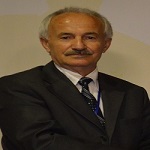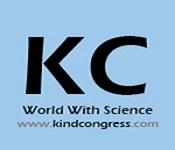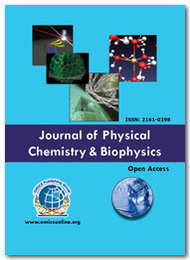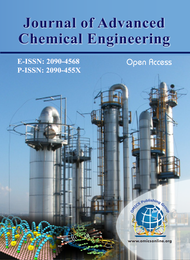Theme: Unique Pioneering Research Strategies and Approaches in Physical and Theoretical Chemistry
Physical Chemistry 2022

Welcome Message
by
Dr. Osman Adiguzel
Dear Distinguished Scholars, Engineers, and Colleagues!
It is my great honour and pleasure as a Committee Member to invite you to join with a contribution to 9th International Conference on Physical and Theoretical Chemistry, November 14-15, 2022, Vancouver, Canada. The Congress will include Plenary and Keynote Speeches and Invited Talks which will be given by Distinguished Scholars and Experts from academic institutions and industry, and oral presentation by delegates and poster presentations by young junior participants.
Devoted to the rapid development of Physical and Theoretical Chemistry, this conference will provide excellent opportunity to meet distinguished scholars and experts and to exchange new ideas and application experiences, to establish research relations and collaborations for future research and projects. The conference has a wide variety of Physical and Theoretical Chemistry from Theoretical and Computational Chemistry, Chemical Physics and Quantum Chemistry to the Solid-State Chemistry and Materials Sciences and Engineering.
International scientific activities are big scientific platforms for the scientists, academicians, and young academicians from all over the world, to interact and communicate with each other.
I believe that Physical Chemistry 2022 Congress will provide this opportunity for delegates from different cultures and countries.
I am pleased to invite prospective scholars and academicians, to submit their original contributions to this important conference, where you are sure to have a meaningful experience with scholars and experts from different cultures and different countries, from all around the World.

Dr. Osman Adiguel, Ph. D.,
Retired professor of Physics,
Firat University,
Elazig, Turkey
With the grand success of Physical Chemistry 2021, Conference Series is now proud to announce the 9th International Conference on Physical and Theoretical Chemistry, which is to be held during November 14-15, 2022 | Vancouver, Canada.
On this great gathering, Organizing Committee invites participants from all over the globe to take part in this annual conference with the theme “ Unique Pioneering Research Strategies and Approaches in Physical and Theoretical Chemistry ”. Physical Chemistry 2022 aims at sharing new ideas and new technologies amongst the professionals, industrialists and students from research areas of Physical Chemistry, Theoretical Chemistry, Electrochemistry, Photochemistry, Computational Chemistry, Chemical Engineering and Chemical Physics to share their recent innovations and applications in various fields and indulge in interactive discussions and technical sessions at the event. The Conference will also have a space for companies and/or institutions to present their services, products, innovations and research results.
Physical and Theoretical Chemistry involves the tracks like Physical Chemistry: A Molecular Approach, Theoretical and Computational Chemistry, Chemical Physics, Photochemistry, Quantum Chemistry, Biophysical Chemistry, Solid-state Chemistry, Spectroscopy, Surface Science, Chemical Kinetics, Electrochemistry, Organometallic Chemistry.
Why to attend???
9th International Conference on Physical and Theoretical Chemistry, which is going to be the biggest conference dedicated to physical and theoretical chemistry professionals providing a premier technical forum for reporting and learning about the latest new generation technologies developed during the course of time along with discussing their applications. Events include hot topics presentations from all over the world and professional networking with industries, leading working groups and panels.
Meet your objective business sector with individuals from and around the globe concentrated on finding out about Physical and Theoretical Chemistry, this is the best chance to achieve the biggest collection of members from everywhere throughout the World. Conduct shows, disperse data, meet with current, make a sprinkle with another product offering, and get name acknowledgment at this occasion. Widely acclaimed speakers, the latest methods, strategies, and the most up to date overhauls in Physical and Theoretical Chemistry are signs of this meeting.
Young Scientist Benefits
- Our conferences provide best Platform for your research through oral presentations.
- Share the ideas with both eminent researchers and mentors.
- Young Scientist Award reorganization certificate and memento to the winners
- Young Scientists will get appropriate and timely information by this Forum.
- Platform for collaboration among young researchers for better development
- Award should motivate participants to strive to realize their full potential which could in turn be beneficial to the field as whole.
Physical Chemistry Conferences | Theoretical Chemistry Conferences | Chemistry Conferences 2022
Track 1: Theoretical and Computational Chemistry
Theoretical chemistry is the discipline that uses quantum mechanics, classical mechanics, and statistical mechanics to explain the structures and dynamics of chemical systems and to correlate, understand, and predict their thermodynamic and kinetic properties. Modern theoretical chemistry may be roughly divided into the study of chemical structure and the study of chemical dynamics. The former includes studies of: (a) electronic structure, potential energy surfaces, and force fields; (b) vibrational-rotational motion; and (c) equilibrium properties of condensed-phase systems and macro-molecules. Chemical dynamics includes: (a) bimolecular kinetics and the collision theory of reactions and energy transfer; (b) unimolecular rate theory and metastable states; and (c) condensed-phase and macromolecular aspects of dynamics.
Related Societies:
Europe: International Association of Physical Chemists, European Association for Chemical and Molecular Sciences, Croatian Chemical Society, Danish Chemical Society, French Chemical Society, German Chemical Society, Societa Chimica Italiana, International Association of Colloid and Interface Scientists, Chemical & Physical Society
USA: The Electrochemical Society, Society of Applied Spectroscopy, The Society of Rheology, Asociacion Argentina de Ingenieria Quimica, Associacao Brasileira de Engenharia Quimica – ABEQ, Instituto Mexicano de Ingenieros Quimicos, A.C. (IMIQ), Sociedad Mexicana de Electroquimica (SME), Sociedad Mexicana de Termodinamica A. C. (SMT), Inter-American Photochemical Society, American Institute of Chemical Engineers
Asia-Pacific: Korean Society of Rheology, Saudi Chemical Society, Indian Chemical Society, Korean Chemical Society, Iranian Journal of Chemistry & Chemical Engineering, Philippine Federation of Chemistry Societies, Israel Chemical Society, Chinese Chemical Society, Federation of Asian Chemical Societies (FACS), Chinese Physical Society
Track 2: Physical Chemistry of Macromolecules
Physical Chemistry of Macromolecules employs the combined principles of physical chemistry to define the behaviour, structure, and intermolecular effects of macromolecules in both solution and bulk states. It emphasizes the statistical measures of structure and weight distribution, and also discusses structural, dynamic, and optical properties of macromolecules in solution.
Related Societies:
Europe: International Association of Physical Chemists, European Association for Chemical and Molecular Sciences, Croatian Chemical Society, Danish Chemical Society, French Chemical Society, German Chemical Society, Societa Chimica Italiana, International Association of Colloid and Interface Scientists, Chemical & Physical Society
USA: The Electrochemical Society, Society of Applied Spectroscopy, The Society of Rheology, Asociacion Argentina de Ingenieria Quimica, Associacao Brasileira de Engenharia Quimica – ABEQ, Instituto Mexicano de Ingenieros Quimicos, A.C. (IMIQ), Sociedad Mexicana de Electroquimica (SME), Sociedad Mexicana de Termodinamica A. C. (SMT), Inter-American Photochemical Society, American Institute of Chemical Engineers
Asia-Pacific: Korean Society of Rheology, Saudi Chemical Society, Indian Chemical Society, Korean Chemical Society, Iranian Journal of Chemistry & Chemical Engineering, Philippine Federation of Chemistry Societies, Israel Chemical Society, Chinese Chemical Society, Federation of Asian Chemical Societies (FACS), Chinese Physical Society
Track 3: Chemical Physics
Chemicalphysics is a sub field of chemistry and physics that investigates physicochemical phenomena using techniques from molecular and atomic physics and condensed matter physics; it is the branch of physics that studies chemical processes from the point of perspective of physics. While at the interface of physics and chemistry, chemical physics is distinct from physical chemistry in that it focuses more on the typical elements and theories of physics. Meanwhile, physical chemistry observes the physical nature of chemistry. Nonetheless, the distinction between the two fields is vague, and workers usually practice in both fields during the course of their research.
Related Societies:
Europe: International Association of Physical Chemists, European Association for Chemical and Molecular Sciences, Croatian Chemical Society, Danish Chemical Society, French Chemical Society, German Chemical Society, Societa Chimica Italiana, International Association of Colloid and Interface Scientists, Chemical & Physical Society
USA: The Electrochemical Society, Society of Applied Spectroscopy, The Society of Rheology, Asociacion Argentina de Ingenieria Quimica, Associacao Brasileira de Engenharia Quimica – ABEQ, Instituto Mexicano de Ingenieros Quimicos, A.C. (IMIQ), Sociedad Mexicana de Electroquimica (SME), Sociedad Mexicana de Termodinamica A. C. (SMT), Inter-American Photochemical Society, American Institute of Chemical Engineers
Asia-Pacific: Korean Society of Rheology, Saudi Chemical Society, Indian Chemical Society, Korean Chemical Society, Iranian Journal of Chemistry & Chemical Engineering, Philippine Federation of Chemistry Societies, Israel Chemical Society, Chinese Chemical Society, Federation of Asian Chemical Societies (FACS), Chinese Physical Society
Track 4: Chemical Kinetics
Chemistry, by its very nature, is related with change. Substances with well-defined properties are converted by chemical reactions into other substances with distinct properties. For any chemical reaction, chemists try to find out the practicality of a chemical reaction which can be predicted by thermodynamics, extent to which a reaction will continue can be determined from chemical equilibrium and speed of a reaction i.e. time taken by a reaction to reach equilibrium. Along with viability and extent, it is equally important to know the rate and the factors controlling the rate of chemical reaction for its thorough understanding. For example, which parameters determine as to how rapidly food gets spoiled? How to design a rapidly setting material for dental filling? Or what controls the rate at which fuel ignites in an auto engine? All these questions can be answered by the branch of chemistry, which deals with the study of reaction rates and their mechanisms, called chemical kinetics.
Related Societies:
Europe: International Association of Physical Chemists, European Association for Chemical and Molecular Sciences, Croatian Chemical Society, Danish Chemical Society, French Chemical Society, German Chemical Society, Societa Chimica Italiana, International Association of Colloid and Interface Scientists, Chemical & Physical Society
USA: The Electrochemical Society, Society of Applied Spectroscopy, The Society of Rheology, Asociacion Argentina de Ingenieria Quimica, Associacao Brasileira de Engenharia Quimica – ABEQ, Instituto Mexicano de Ingenieros Quimicos, A.C. (IMIQ), Sociedad Mexicana de Electroquimica (SME), Sociedad Mexicana de Termodinamica A. C. (SMT), Inter-American Photochemical Society, American Institute of Chemical Engineers
Asia-Pacific: Korean Society of Rheology, Saudi Chemical Society, Indian Chemical Society, Korean Chemical Society, Iranian Journal of Chemistry & Chemical Engineering, Philippine Federation of Chemistry Societies, Israel Chemical Society, Chinese Chemical Society, Federation of Asian Chemical Societies (FACS), Chinese Physical Society
Track 5: Surface Science
Surface science is the study of physical and chemical phenomenon that occur at the interface of two phases, including solid–liquid interfaces, solid–gas interfaces, solid–vacuum interfaces, and liquid–gas interfaces. It includes the fields of surface chemistry and surface physics. Surface chemistry can be roughly defined as the study of chemical reactions at interfaces. It is closely associated to surface engineering, which aims at modifying the chemical composition of a surface by incorporation of selected elements or functional groups that generate various desired effects or improvements in the properties of the surface or interface. Surface science is of specific importance to the fields of heterogeneous catalysis, electrochemistry, and geochemistry.
Related Societies:
Europe: International Association of Physical Chemists, European Association for Chemical and Molecular Sciences, Croatian Chemical Society, Danish Chemical Society, French Chemical Society, German Chemical Society, Societa Chimica Italiana, International Association of Colloid and Interface Scientists, Chemical & Physical Society
USA: The Electrochemical Society, Society of Applied Spectroscopy, The Society of Rheology, Asociacion Argentina de Ingenieria Quimica, Associacao Brasileira de Engenharia Quimica – ABEQ, Instituto Mexicano de Ingenieros Quimicos, A.C. (IMIQ), Sociedad Mexicana de Electroquimica (SME), Sociedad Mexicana de Termodinamica A. C. (SMT), Inter-American Photochemical Society, American Institute of Chemical Engineers
Asia-Pacific: Korean Society of Rheology, Saudi Chemical Society, Indian Chemical Society, Korean Chemical Society, Iranian Journal of Chemistry & Chemical Engineering, Philippine Federation of Chemistry Societies, Israel Chemical Society, Chinese Chemical Society, Federation of Asian Chemical Societies (FACS), Chinese Physical Society
Track 6: Spectroscopy
Spectroscopy is study of the absorption and emission of light and other radiation by matter, as related to the dependence of these procedures on the wavelength of the radiation. More recently, the definition has been expanded to include the study of the relations between particles such as electrons, protons, and ions, as well as their interaction with other particles as a role of their collision energy. Spectroscopic analysis has been crucial in the development of the most fundamental hypothesis in physics, including quantum mechanics, the special and general theories of relativity, and quantum electrodynamics. Spectroscopy, as applied to high-energy collisions, has been a key tool in developing scientific consideration not only of the electromagnetic force but also of the strong and weak nuclear forces.
Spectroscopic techniques are exceptionally sensitive. Single atoms and even different isotopes of the same atom can be detected among 1020 or more atoms of a distinct species. Trace amounts of pollutants or contaminants are often detected most effectively by spectroscopic techniques.
Related Societies:
Europe: International Association of Physical Chemists, European Association for Chemical and Molecular Sciences, Croatian Chemical Society, Danish Chemical Society, French Chemical Society, German Chemical Society, Societa Chimica Italiana, International Association of Colloid and Interface Scientists, Chemical & Physical Society
USA: The Electrochemical Society, Society of Applied Spectroscopy, The Society of Rheology, Asociacion Argentina de Ingenieria Quimica, Associacao Brasileira de Engenharia Quimica – ABEQ, Instituto Mexicano de Ingenieros Quimicos, A.C. (IMIQ), Sociedad Mexicana de Electroquimica (SME), Sociedad Mexicana de Termodinamica A. C. (SMT), Inter-American Photochemical Society, American Institute of Chemical Engineers
Asia-Pacific: Korean Society of Rheology, Saudi Chemical Society, Indian Chemical Society, Korean Chemical Society, Iranian Journal of Chemistry & Chemical Engineering, Philippine Federation of Chemistry Societies, Israel Chemical Society, Chinese Chemical Society, Federation of Asian Chemical Societies (FACS), Chinese Physical Society
Track 7: Photochemistry
The study of chemical reactions, isomerizations and physical behavior that may occur under the influence of visible and/or ultraviolet light is known as Photochemistry. Photochemistry is the underlying mechanism for all of photobiology. When a molecule absorbs a photon of light, its electronic constitution changes, and it reacts differently with other molecules. The energy that is absorbed from light can effect in photochemical changes in the absorbing molecule, or in an adjacent molecule (e.g., photosensitization). The energy can also be set off as heat, or as lower energy light, i.e., fluorescence or phosphorescence, in order to give back the molecule to its ground state. Each type of molecule has a different preference for which of these different mechanisms it utilizes to get rid of absorbed photon energy, e.g., some prefer fluorescence over chemistry.
Related Societies:
Europe: International Association of Physical Chemists, European Association for Chemical and Molecular Sciences, Croatian Chemical Society, Danish Chemical Society, French Chemical Society, German Chemical Society, Societa Chimica Italiana, International Association of Colloid and Interface Scientists, Chemical & Physical Society
USA: The Electrochemical Society, Society of Applied Spectroscopy, The Society of Rheology, Asociacion Argentina de Ingenieria Quimica, Associacao Brasileira de Engenharia Quimica – ABEQ, Instituto Mexicano de Ingenieros Quimicos, A.C. (IMIQ), Sociedad Mexicana de Electroquimica (SME), Sociedad Mexicana de Termodinamica A. C. (SMT), Inter-American Photochemical Society, American Institute of Chemical Engineers
Asia-Pacific: Korean Society of Rheology, Saudi Chemical Society, Indian Chemical Society, Korean Chemical Society, Iranian Journal of Chemistry & Chemical Engineering, Philippine Federation of Chemistry Societies, Israel Chemical Society, Chinese Chemical Society, Federation of Asian Chemical Societies (FACS), Chinese Physical Society
Track 8: Biophysics
Biophysics is the study of physical phenomena and physical processes in living things, on scales spanning molecules, cells, tissues, and organisms. Biophysicists use the principles and methods of physics to understand biological systems. It is an interdisciplinary science, closely related to quantitative and systems biology. Biophysics is the field that applies the theories and methods of physics to understand how biological systems work.
Related Societies:
Europe: International Association of Physical Chemists, European Association for Chemical and Molecular Sciences, Croatian Chemical Society, Danish Chemical Society, French Chemical Society, German Chemical Society, Societa Chimica Italiana, International Association of Colloid and Interface Scientists, Chemical & Physical Society
USA: The Electrochemical Society, Society of Applied Spectroscopy, The Society of Rheology, Asociacion Argentina de Ingenieria Quimica, Associacao Brasileira de Engenharia Quimica – ABEQ, Instituto Mexicano de Ingenieros Quimicos, A.C. (IMIQ), Sociedad Mexicana de Electroquimica (SME), Sociedad Mexicana de Termodinamica A. C. (SMT), Inter-American Photochemical Society, American Institute of Chemical Engineers
Asia-Pacific: Korean Society of Rheology, Saudi Chemical Society, Indian Chemical Society, Korean Chemical Society, Iranian Journal of Chemistry & Chemical Engineering, Philippine Federation of Chemistry Societies, Israel Chemical Society, Chinese Chemical Society, Federation of Asian Chemical Societies (FACS), Chinese Physical Society
Track 9: Quantum Chemistry
Quantum chemistry is a field of chemistry whose primary focus is the application of quantum mechanics in physical models and experiments of chemical systems. It is also known as molecular quantum mechanics. Quantum chemistry is the application of quantum mechanical theories and equations to the study of molecules. In order to understand matter at its most fundamental measure, we must utilize quantum mechanical models and methods. There are two aspects of quantum mechanics that make it differ from previous models of matter. The first is the concept of wave-particle duality; that is, the notion that we want to think of very small objects (such as electrons) as having characteristics of both particles and waves. Second, quantum mechanical models precisely predict that the energy of atoms and molecules is always quantized, meaning that they may have only certain amounts of energy. Quantum chemical theories allow us to elucidate the structure of the periodic table, and quantum chemical calculations allow us to accurately predict the structures of molecules and the spectroscopic behaviour of atoms and molecules.
Related Societies:
Europe: International Association of Physical Chemists, European Association for Chemical and Molecular Sciences, Croatian Chemical Society, Danish Chemical Society, French Chemical Society, German Chemical Society, Societa Chimica Italiana, International Association of Colloid and Interface Scientists, Chemical & Physical Society
USA: The Electrochemical Society, Society of Applied Spectroscopy, The Society of Rheology, Asociacion Argentina de Ingenieria Quimica, Associacao Brasileira de Engenharia Quimica – ABEQ, Instituto Mexicano de Ingenieros Quimicos, A.C. (IMIQ), Sociedad Mexicana de Electroquimica (SME), Sociedad Mexicana de Termodinamica A. C. (SMT), Inter-American Photochemical Society, American Institute of Chemical Engineers
Asia-Pacific: Korean Society of Rheology, Saudi Chemical Society, Indian Chemical Society, Korean Chemical Society, Iranian Journal of Chemistry & Chemical Engineering, Philippine Federation of Chemistry Societies, Israel Chemical Society, Chinese Chemical Society, Federation of Asian Chemical Societies (FACS), Chinese Physical Society
Track 10: Solid-state Chemistry
Solid-state chemistry, also sometimes mentioned to as materials chemistry, is the study of the synthesis, structure, and properties of solid phase materials, peculiarly, but not necessarily exclusively of, non-molecular solids. Solid-state chemistry continues to play an amplifying role in an astounding array of disciplines. As the discovery of new physical phenomena has often depended on the progression of new materials, the synthesis of new solid-state materials and kinetically solid composites with optimized properties is of central importance. While solid-state materials have historically been developed through high temperature solid-state reactions, generally affording the most thermodynamically stable phases, a variety of techniques have been developed to master the limitations inherent in this traditional approach.
Related Societies:
Europe: International Association of Physical Chemists, European Association for Chemical and Molecular Sciences, Croatian Chemical Society, Danish Chemical Society, French Chemical Society, German Chemical Society, Societa Chimica Italiana, International Association of Colloid and Interface Scientists, Chemical & Physical Society
USA: The Electrochemical Society, Society of Applied Spectroscopy, The Society of Rheology, Asociacion Argentina de Ingenieria Quimica, Associacao Brasileira de Engenharia Quimica – ABEQ, Instituto Mexicano de Ingenieros Quimicos, A.C. (IMIQ), Sociedad Mexicana de Electroquimica (SME), Sociedad Mexicana de Termodinamica A. C. (SMT), Inter-American Photochemical Society, American Institute of Chemical Engineers
Asia-Pacific: Korean Society of Rheology, Saudi Chemical Society, Indian Chemical Society, Korean Chemical Society, Iranian Journal of Chemistry & Chemical Engineering, Philippine Federation of Chemistry Societies, Israel Chemical Society, Chinese Chemical Society, Federation of Asian Chemical Societies (FACS), Chinese Physical Society
Track 11: Biophysical Chemistry
Biophysical chemistry is a physical science that uses the concepts of physics and physical chemistry for the study of biological systems. The most common feature of the research in this subject is to seek explanation of the various phenomena in biological systems in terms of either the molecules that make up the system or the supra-molecular structure of these systems. Biophysical chemists employ various techniques used in physical chemistry to probe the structure of biological systems. These techniques include spectroscopic methods such as nuclear magnetic resonance (NMR) and X-ray diffraction.
Related Societies:
Europe: International Association of Physical Chemists, European Association for Chemical and Molecular Sciences, Croatian Chemical Society, Danish Chemical Society, French Chemical Society, German Chemical Society, Societa Chimica Italiana, International Association of Colloid and Interface Scientists, Chemical & Physical Society
USA: The Electrochemical Society, Society of Applied Spectroscopy, The Society of Rheology, Asociacion Argentina de Ingenieria Quimica, Associacao Brasileira de Engenharia Quimica – ABEQ, Instituto Mexicano de Ingenieros Quimicos, A.C. (IMIQ), Sociedad Mexicana de Electroquimica (SME), Sociedad Mexicana de Termodinamica A. C. (SMT), Inter-American Photochemical Society, American Institute of Chemical Engineers
Asia-Pacific: Korean Society of Rheology, Saudi Chemical Society, Indian Chemical Society, Korean Chemical Society, Iranian Journal of Chemistry & Chemical Engineering, Philippine Federation of Chemistry Societies, Israel Chemical Society, Chinese Chemical Society, Federation of Asian Chemical Societies (FACS), Chinese Physical Society
Track 12: Electrochemistry
Electrochemistry is the branch of chemistry which deals with the chemical changes caused in the matter by passage of electric current and conversion of chemical energy into electrical energy and vice versa. Electrochemistry deals with the study of electrical properties of solutions of electrolytes and with the interrelation of chemical phenomenon and electrical energies. It is the study of production of electricity from energy released during impulsive chemical reactions and the use of electrical energy to bring about non-spontaneous chemical reactions. Electrochemistry is not only limited up to chemistry but its branches extend to physics and biology also.
Related Societies:
Europe: International Association of Physical Chemists, European Association for Chemical and Molecular Sciences, Croatian Chemical Society, Danish Chemical Society, French Chemical Society, German Chemical Society, Societa Chimica Italiana, International Association of Colloid and Interface Scientists, Chemical & Physical Society
USA: The Electrochemical Society, Society of Applied Spectroscopy, The Society of Rheology, Asociacion Argentina de Ingenieria Quimica, Associacao Brasileira de Engenharia Quimica – ABEQ, Instituto Mexicano de Ingenieros Quimicos, A.C. (IMIQ), Sociedad Mexicana de Electroquimica (SME), Sociedad Mexicana de Termodinamica A. C. (SMT), Inter-American Photochemical Society, American Institute of Chemical Engineers
Asia-Pacific: Korean Society of Rheology, Saudi Chemical Society, Indian Chemical Society, Korean Chemical Society, Iranian Journal of Chemistry & Chemical Engineering, Philippine Federation of Chemistry Societies, Israel Chemical Society, Chinese Chemical Society, Federation of Asian Chemical Societies (FACS), Chinese Physical Society
Track 13: Organometallic Chemistry
Organometallic-chemistry is the study of the chemical synthesis, chemical structure and reactivity of chemical combination that carry metal carbon bonds, these compounds are often used as similar catalysts. Organometallic compounds, matter containing one metal to carbon atoms in which the carbon is piece of an organic group. Organometallic compounds played a major part in the development of chemistry structures. The physicochemical characteristics of organometallic compounds are solids, some are liquids and some are gases.
Related Societies:
Europe: International Association of Physical Chemists, European Association for Chemical and Molecular Sciences, Croatian Chemical Society, Danish Chemical Society, French Chemical Society, German Chemical Society, Societa Chimica Italiana, International Association of Colloid and Interface Scientists, Chemical & Physical Society
USA: The Electrochemical Society, Society of Applied Spectroscopy, The Society of Rheology, Asociacion Argentina de Ingenieria Quimica, Associacao Brasileira de Engenharia Quimica – ABEQ, Instituto Mexicano de Ingenieros Quimicos, A.C. (IMIQ), Sociedad Mexicana de Electroquimica (SME), Sociedad Mexicana de Termodinamica A. C. (SMT), Inter-American Photochemical Society, American Institute of Chemical Engineers
Asia-Pacific: Korean Society of Rheology, Saudi Chemical Society, Indian Chemical Society, Korean Chemical Society, Iranian Journal of Chemistry & Chemical Engineering, Philippine Federation of Chemistry Societies, Israel Chemical Society, Chinese Chemical Society, Federation of Asian Chemical Societies (FACS), Chinese Physical Society
Track 14: Femtochemistry
Femto Chemistry is the branch of chemistry that study’s chemical reaction on extremely short timescale. To study the act of rearranging of atoms within the molecules to form new molecules.
Related Societies:
Europe: International Association of Physical Chemists, European Association for Chemical and Molecular Sciences, Croatian Chemical Society, Danish Chemical Society, French Chemical Society, German Chemical Society, Societa Chimica Italiana, International Association of Colloid and Interface Scientists, Chemical & Physical Society
USA: The Electrochemical Society, Society of Applied Spectroscopy, The Society of Rheology, Asociacion Argentina de Ingenieria Quimica, Associacao Brasileira de Engenharia Quimica – ABEQ, Instituto Mexicano de Ingenieros Quimicos, A.C. (IMIQ), Sociedad Mexicana de Electroquimica (SME), Sociedad Mexicana de Termodinamica A. C. (SMT), Inter-American Photochemical Society, American Institute of Chemical Engineers
Asia-Pacific: Korean Society of Rheology, Saudi Chemical Society, Indian Chemical Society, Korean Chemical Society, Iranian Journal of Chemistry & Chemical Engineering, Philippine Federation of Chemistry Societies, Israel Chemical Society, Chinese Chemical Society, Federation of Asian Chemical Societies (FACS), Chinese Physical Society
Track 15: Solution and Thermodynamics
Thermodynamics is the study of relations between heat, work, temperature, and energy. The most important laws of thermodynamics are the zeroth law of thermodynamics, The first law of thermodynamics, The second law of thermodynamics, The third law of thermodynamics. Thermodynamics applies to a wide variety of topics in both science and engineering. Some of the applications includes Ice cubes in a drink absorb heat from the drink making the drink cooler.
Related Societies:
Europe: International Association of Physical Chemists, European Association for Chemical and Molecular Sciences, Croatian Chemical Society, Danish Chemical Society, French Chemical Society, German Chemical Society, Societa Chimica Italiana, International Association of Colloid and Interface Scientists, Chemical & Physical Society
USA: The Electrochemical Society, Society of Applied Spectroscopy, The Society of Rheology, Asociacion Argentina de Ingenieria Quimica, Associacao Brasileira de Engenharia Quimica – ABEQ, Instituto Mexicano de Ingenieros Quimicos, A.C. (IMIQ), Sociedad Mexicana de Electroquimica (SME), Sociedad Mexicana de Termodinamica A. C. (SMT), Inter-American Photochemical Society, American Institute of Chemical Engineers
Asia-Pacific: Korean Society of Rheology, Saudi Chemical Society, Indian Chemical Society, Korean Chemical Society, Iranian Journal of Chemistry & Chemical Engineering, Philippine Federation of Chemistry Societies, Israel Chemical Society, Chinese Chemical Society, Federation of Asian Chemical Societies (FACS), Chinese Physical Society
Track 16: Material Science and Engineering
Material Science and Engineering mainly covers the design and discovery of new materials, particularly solids. Development of new materials and their successive application depends on a fundamental understanding of their molecular structure, relating the structure to material properties, performance, and the bonding between atoms. Some of the applications include Atomic Resolution Microscopy, Biomaterials– Borrowing from Nature, Structural Imaging and Analysis, Difficult Sample Preparation. Materials science is also a crucial part of forensic engineering and failure analysis.
Related Societies:
Europe: International Association of Physical Chemists, European Association for Chemical and Molecular Sciences, Croatian Chemical Society, Danish Chemical Society, French Chemical Society, German Chemical Society, Societa Chimica Italiana, International Association of Colloid and Interface Scientists, Chemical & Physical Society
USA: The Electrochemical Society, Society of Applied Spectroscopy, The Society of Rheology, Asociacion Argentina de Ingenieria Quimica, Associacao Brasileira de Engenharia Quimica – ABEQ, Instituto Mexicano de Ingenieros Quimicos, A.C. (IMIQ), Sociedad Mexicana de Electroquimica (SME), Sociedad Mexicana de Termodinamica A. C. (SMT), Inter-American Photochemical Society, American Institute of Chemical Engineers
Asia-Pacific: Korean Society of Rheology, Saudi Chemical Society, Indian Chemical Society, Korean Chemical Society, Iranian Journal of Chemistry & Chemical Engineering, Philippine Federation of Chemistry Societies, Israel Chemical Society, Chinese Chemical Society, Federation of Asian Chemical Societies (FACS), Chinese Physical Society
Track 17: Nanoscience and Nanotechnology
Nanoscience is an Interdisciplinary field refers to the study, manipulation and engineering of matter, particles, and structures on the nanometer scale (one millionth of a millimeter, the scale of atoms and molecules). Some of the important properties of materials, such as the electrical, optical, thermal, and mechanical properties, are determined by the way molecules and atoms assemble on the nanoscale into larger structures. In addition, nanometer size structures these properties often different then on macroscale, because quantum mechanical effects become important. Nanotechnology is the application of nanoscience which leads to the use of new nanomaterials and nanosized components in useful products
Related Societies:
Europe: International Association of Physical Chemists, European Association for Chemical and Molecular Sciences, Croatian Chemical Society, Danish Chemical Society, French Chemical Society, German Chemical Society, Societa Chimica Italiana, International Association of Colloid and Interface Scientists, Chemical & Physical Society
USA: The Electrochemical Society, Society of Applied Spectroscopy, The Society of Rheology, Asociacion Argentina de Ingenieria Quimica, Associacao Brasileira de Engenharia Quimica – ABEQ, Instituto Mexicano de Ingenieros Quimicos, A.C. (IMIQ), Sociedad Mexicana de Electroquimica (SME), Sociedad Mexicana de Termodinamica A. C. (SMT), Inter-American Photochemical Society, American Institute of Chemical Engineers
Asia-Pacific: Korean Society of Rheology, Saudi Chemical Society, Indian Chemical Society, Korean Chemical Society, Iranian Journal of Chemistry & Chemical Engineering, Philippine Federation of Chemistry Societies, Israel Chemical Society, Chinese Chemical Society, Federation of Asian Chemical Societies (FACS), Chinese Physical Society
Track 18: Organic-Inorganic Chemistry
Organic chemistry is the study of carbon-containing compounds and inorganic chemistry is the study of the remaining (i.e., not carbon-containing) subset of compounds. Both Organic and Inorganic Chemistry are concerned with properties, Reactions, Structures, and synthesis of various chemicals. Molecules associated with living organisms are organic. These include nucleic acids, fats, sugars, proteins, enzymes, and hydrocarbon fuels. Some of the subfields of Inorganic Chemistry focus on electrical conductivity of inorganic materials
Related Societies:
Europe: International Association of Physical Chemists, European Association for Chemical and Molecular Sciences, Croatian Chemical Society, Danish Chemical Society, French Chemical Society, German Chemical Society, Societa Chimica Italiana, International Association of Colloid and Interface Scientists, Chemical & Physical Society
USA: The Electrochemical Society, Society of Applied Spectroscopy, The Society of Rheology, Asociacion Argentina de Ingenieria Quimica, Associacao Brasileira de Engenharia Quimica – ABEQ, Instituto Mexicano de Ingenieros Quimicos, A.C. (IMIQ), Sociedad Mexicana de Electroquimica (SME), Sociedad Mexicana de Termodinamica A. C. (SMT), Inter-American Photochemical Society, American Institute of Chemical Engineers
Asia-Pacific: Korean Society of Rheology, Saudi Chemical Society, Indian Chemical Society, Korean Chemical Society, Iranian Journal of Chemistry & Chemical Engineering, Philippine Federation of Chemistry Societies, Israel Chemical Society, Chinese Chemical Society, Federation of Asian Chemical Societies (FACS), Chinese Physical Society
Track 19: Green Chemistry and Catalysis
Green chemistry is the main design of chemical products and processes that reduce or eliminate the generation of hazardous substances. EPA's efforts to speed the adoption of this revolutionary and diverse discipline have led to greater environmental benefits, innovation, and a strengthened economy. The key principles of green chemistry are Prevention, Atom Economy, fewer hazards, Safe Chemicals, Safer solvents, Energy Efficiency, Renewable feedstocks, Reduce derivatives, Smart catalysis, Degradable design, Hazard and accident prevention, Real-time analysis for pollution prevention
Related Societies:
Europe: International Association of Physical Chemists, European Association for Chemical and Molecular Sciences, Croatian Chemical Society, Danish Chemical Society, French Chemical Society, German Chemical Society, Societa Chimica Italiana, International Association of Colloid and Interface Scientists, Chemical & Physical Society
USA: The Electrochemical Society, Society of Applied Spectroscopy, The Society of Rheology, Asociacion Argentina de Ingenieria Quimica, Associacao Brasileira de Engenharia Quimica – ABEQ, Instituto Mexicano de Ingenieros Quimicos, A.C. (IMIQ), Sociedad Mexicana de Electroquimica (SME), Sociedad Mexicana de Termodinamica A. C. (SMT), Inter-American Photochemical Society, American Institute of Chemical Engineers
Asia-Pacific: Korean Society of Rheology, Saudi Chemical Society, Indian Chemical Society, Korean Chemical Society, Iranian Journal of Chemistry & Chemical Engineering, Philippine Federation of Chemistry Societies, Israel Chemical Society, Chinese Chemical Society, Federation of Asian Chemical Societies (FACS), Chinese Physical Society
Track 20: Medicinal Chemistry
Medicinal Chemistry and pharmaceutical science are disciplines at the conjunction of science, mainly synthetic organic science, and pharmacology and different other organic claims to fame, where they are included with plan, compound amalgamation and advancement for market of pharmaceutical specialists, or bio-dynamic atoms (drugs).
Specially, restorative science in its most basic work on—concentrating on organic compounds —envelops manufactured organic chemistry and parts of common items and computational science in close blend with biological chemistry, enzymology and auxiliary science, together going for the disclosure and improvement of new helpful operators. Basically, it includes concoction parts of ID, and after that orderly, exhaustive engineered adjustment of new substance elements to make them reasonable for helpful utilize. It incorporates manufactured and computational parts of the investigation of existing medications and operators being developed in connection to their bioactivities (natural exercises and properties), i.e., understanding their structure-action connections (SAR). Pharmaceutical science is centered around quality parts of prescriptions and expects to guarantee wellness for motivation behind restorative products.
At the organic interface, restorative chemistry consolidates to shape an arrangement of exceedingly interdisciplinary sciences, setting its organic, physical, and computational accentuations nearby organic ranges, for example, organic chemistry, atomic science, pharmacognosy and pharmacology, toxicology and veterinary and human medication; these, with extend administration, insights, and pharmaceutical business rehearses, methodically shortest.
Related Societies:
Europe: International Association of Physical Chemists, European Association for Chemical and Molecular Sciences, Croatian Chemical Society, Danish Chemical Society, French Chemical Society, German Chemical Society, Societa Chimica Italiana, International Association of Colloid and Interface Scientists, Chemical & Physical Society
USA: The Electrochemical Society, Society of Applied Spectroscopy, The Society of Rheology, Asociacion Argentina de Ingenieria Quimica, Associacao Brasileira de Engenharia Quimica – ABEQ, Instituto Mexicano de Ingenieros Quimicos, A.C. (IMIQ), Sociedad Mexicana de Electroquimica (SME), Sociedad Mexicana de Termodinamica A. C. (SMT), Inter-American Photochemical Society, American Institute of Chemical Engineers
Asia-Pacific: Korean Society of Rheology, Saudi Chemical Society, Indian Chemical Society, Korean Chemical Society, Iranian Journal of Chemistry & Chemical Engineering, Philippine Federation of Chemistry Societies, Israel Chemical Society
Track 21: Chemical Kinetics and Reaction Engineering
Chemical kinetics is the branch of physical chemistry that is concerned with understanding the rates of chemical reactions. Based on this rate, chemical reactions can be classified as fast moderate and slow reactions. Factors affecting the reaction rate are Nature of reactants, Physical State, Surface area of solid state, Concentration, Temperature, Catalysts, Pressure, and Absorption of light. Chemical reaction engineering is a specialty in industrial chemistry or chemical engineering mainly deals with chemical reactors. Chemical reaction engineering is a specific engineering activity emphasizing on successful design and operation of chemical reactors and it is associated with the exploitation of chemical reactions on laboratory to the commercial scale.
Related Societies:
Europe: International Association of Physical Chemists, European Association for Chemical and Molecular Sciences, Croatian Chemical Society, Danish Chemical Society, French Chemical Society, German Chemical Society, Societa Chimica Italiana, International Association of Colloid and Interface Scientists, Chemical & Physical Society
USA: The Electrochemical Society, Society of Applied Spectroscopy, The Society of Rheology, Asociacion Argentina de Ingenieria Quimica, Associacao Brasileira de Engenharia Quimica – ABEQ, Instituto Mexicano de Ingenieros Quimicos, A.C. (IMIQ), Sociedad Mexicana de Electroquimica (SME), Sociedad Mexicana de Termodinamica A. C. (SMT), Inter-American Photochemical Society, American Institute of Chemical Engineers
Asia-Pacific: Korean Society of Rheology, Saudi Chemical Society, Indian Chemical Society, Korean Chemical Society, Iranian Journal of Chemistry & Chemical Engineering, Philippine Federation of Chemistry Societies, Israel Chemical Society, Chinese Chemical Society, Federation of Asian Chemical Societies (FACS), Chinese Physical Society
Track 22: Chemical Engineering & Thermochemistry
Chemical engineering is the multidisciplinary branch of engineering that deals with chemical production and the manufacture of products through chemical processes. This includes designing equipment, systems, and processes for refining raw materials and for mixing, compounding, and processing chemicals to make higher quality products. Thermochemistry is a branch of chemistry that describes the energy changes that occur during chemical reactions. Thermochemistry is concerned with a change in energy mainly regarding an exchange of energy of a system with its surroundings.
Related Societies:
Europe: International Association of Physical Chemists, European Association for Chemical and Molecular Sciences, Croatian Chemical Society, Danish Chemical Society, French Chemical Society, German Chemical Society, Societa Chimica Italiana, International Association of Colloid and Interface Scientists, Chemical & Physical Society
USA: The Electrochemical Society, Society of Applied Spectroscopy, The Society of Rheology, Asociacion Argentina de Ingenieria Quimica, Associacao Brasileira de Engenharia Quimica – ABEQ, Instituto Mexicano de Ingenieros Quimicos, A.C. (IMIQ), Sociedad Mexicana de Electroquimica (SME), Sociedad Mexicana de Termodinamica A. C. (SMT), Inter-American Photochemical Society, American Institute of Chemical Engineers
Asia-Pacific: Korean Society of Rheology, Saudi Chemical Society, Indian Chemical Society, Korean Chemical Society, Iranian Journal of Chemistry & Chemical Engineering, Philippine Federation of Chemistry Societies, Israel Chemical Society, Chinese Chemical Society, Federation of Asian Chemical Societies (FACS), Chinese Physical Society
Track 23: Spectroscopic Analysis
Spectroscopic analysis is employed to explore hybrid composites, providing practical information such as chemical composition, elemental type, optical & electronic properties, and crystallinity. Spectroscopic techniques have been applied in virtually in all technical fields of science and technology. Spectroscopy is a branch of science mainly concerned with the spectra of electromagnetic radiation as a function of its wavelength or frequency and it is measured by spectrographic equipment
Related Societies:
Europe: International Association of Physical Chemists, European Association for Chemical and Molecular Sciences, Croatian Chemical Society, Danish Chemical Society, French Chemical Society, German Chemical Society, Societa Chimica Italiana, International Association of Colloid and Interface Scientists, Chemical & Physical Society
USA: The Electrochemical Society, Society of Applied Spectroscopy, The Society of Rheology, Asociacion Argentina de Ingenieria Quimica, Associacao Brasileira de Engenharia Quimica – ABEQ, Instituto Mexicano de Ingenieros Quimicos, A.C. (IMIQ), Sociedad Mexicana de Electroquimica (SME), Sociedad Mexicana de Termodinamica A. C. (SMT), Inter-American Photochemical Society, American Institute of Chemical Engineers
Asia-Pacific: Korean Society of Rheology, Saudi Chemical Society, Indian Chemical Society, Korean Chemical Society, Iranian Journal of Chemistry & Chemical Engineering, Philippine Federation of Chemistry Societies, Israel Chemical Society, Chinese Chemical Society, Federation of Asian Chemical Societies (FACS), Chinese Physical Society
Track 24: Agricultural Chemistry
Agricultural chemistry is a science concerned with ways to influence chemical and biochemical processes in soil and plants, with plant mineral nutrition, using fertilizers and other chemical means to improve fertility and increase yield. It is also closely linked to soil science, forestry, meteorology, plant and biochemistry, agricultural microbiology, physics and chemistry.
Physical Chemistry 2021
8th International Conference on Physical and Theoretical Chemistry
Conference series hosted 8th International Conference on Physical and Theoretical Chemistry September 13-14, 2021 Rome, Italy.
Active participation and generous response were received from the Organizing Committee Members, scientists, researchers, as well as experts from Non-government organizations, and students from diverse groups who made this conference as one of the most successful and productive events in 2020 from Conference series.
The conference was marked with several workshops, multiple sessions, Keynote presentations, panel discussions and Poster sessions. We received active participation from scientists, young and brilliant researchers, business delegates and talented student communities representing more than 35 countries, who have driven this event into the path of success.
The conference was initiated with a warm welcome note by Honorable guests and the Keynote forum. The conference proceedings were carried out through various Scientific-sessions and plenary lectures, of which the following Speakers were highlighted as Keynote speakers:
We are obliged to the various delegates from companies and institutes who actively took part in the discussions. We sincerely thank the Organizing Committee Members and Editorial board of Physical Chemistry 2021 for their gracious presence and continuous support throughout the proceedings of this event. With the valuable feedback and generous response received from the participants of the event, Conference Series would like to announce the commencement of “9th International Conference on Physical and Theoretical Chemistry 2022”
For details Visit: https://physicalchemistry.chemistryconferences.org/
Global Market Value of Physical Chemistry
The global chemical industry is estimated to be US $2.4 trillion dollars contributing significantly in the market growth of US, Europe, and Middle East Countries. The demand for chemical products is highest in the Asia, Japan and Korea. The annual US chemical output alone is US $750 billion dollars. The global chemical industry market is expected to grow at a CAGR of 3.7% by 2021. According to American Chemistry Council, the global chemicals industry breached the US$5 trillion sales mark in 2013. According to the U.S. Bureau of Labor Statistics, chemists and material scientists can expect their field to grow slower than average through 2021. Growth markets such as China, Brazil, and India stimulate demand for basic chemicals whereas in developed regions, chemicals formulated for specialized applications will see a progressive rise in demand. The cellulose ether & derivatives market is projected to be worth USD 6.30 Billion, by 2020, registering a CAGR of 7.2% between 2015 and 2020. The global carbon nanotubes market size (2015–2020) is estimated to reach USD 5.64 Billion by 2021 at a CAGR of 20.1%. The market size of amines is estimated to grow from USD 13.35 Billion in 2015 to USD 19.90 Billion by 2020.
Leading vendors in the market are, Agilent, Bruker, HORIBA, Danaher, Thermo Fischer. Other vendors in the market include ABB, B&W Tek, Hitachi, Illumina, JASCO, PerkinElmer, Siemens, and Waters.
Major Universities associated with Physical Chemistry
University of California - ​Berkeley
California Institute of Technology
Massachusetts Institute of Technology
Stanford University
Northwestern University
Lyon University
Örebro University
BabeÈ™-Bolyai University
University of Mons
North-Eastern Federal University in Yakutsk
Major Societies associated with Physical Chemistry
Royal Society of Chemistry
Society of Physical Chemists of Serbia
ChemPubSoc Europe
Asian Chemical Editorial Society
German Bunsen Society for Physical Chemistry
Institute of Chemistry of Ireland
Korean Physical Society
The Danish Chemical Society
Swiss Chemical Society
Polskie Towarzystwo Chemiczne
Eminent Members associated with Physical Chemistry
Mario Molina, Nobel Laureate
Richard R. Ernst, Nobel Laureate
Mostafa El-Sayed, US National Medal of Science laureate
Gerhard Ertl, Nobel Laureate
Benjamin S. Hsiao, Chief Research Officer at Stony Brook University
Conference Highlights
- Theoretical and Computational Chemistry
- Physical Chemistry of Macromolecules
- Chemical Kinetics
- Chemical Physics
- Surface Science
- Spectroscopy
- Photochemistry
- Biophysics
- Quantum Chemistry
- Solid-state Chemistry
- Biophysical Chemistry
- Electrochemistry
- Organometallic Chemistry
- Femto chemistry
- Solution and Thermodynamics
- Material Science and Engineering
- Nanoscience and Nanotechnology
- Organic-Inorganic Chemistry
- Green Chemistry and Catalysis
- Chemical Kinetics and Reaction Engineering
- Chemical Engineering & Thermochemistry
- Spectroscopic Analysis
- Medicinal Chemistry
- Agricultural Chemistry
To share your views and research, please click here to register for the Conference.
To Collaborate Scientific Professionals around the World
| Conference Date | November 14-15, 2022 | ||
| Sponsors & Exhibitors |
|
||
| Speaker Opportunity Closed | Day 1 | ||
| Poster Opportunity Closed | Click Here to View | ||
Useful Links
Special Issues
All accepted abstracts will be published in respective Our International Journals.
Abstracts will be provided with Digital Object Identifier by















